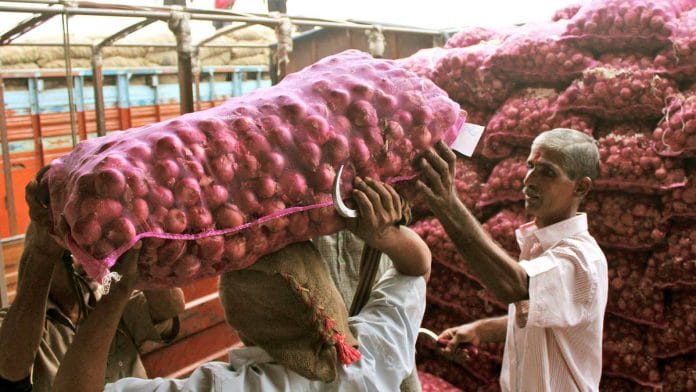New Delhi: Onion prices are unlikely to pinch Indian household budgets this year as the Narendra Modi government has nearly completed the build-up of buffer stock to intervene in case of any unexpected price hike in the market.
Usually, the retail as well as wholesale prices of staple kitchen commodities witness a steep hike in the lean supply season between September and November. To tackle this, the Centre maintains buffer stocks to make price stabilising interventions while supporting farmers.
Earlier this year, the Modi government decided to double the cap on buffer stock of commodities to 2 lakh metric tonnes (LMT) after two consecutive years in which the onion prices touched Rs 100 per kg.
As of 31 July, government agencies, including the National Agricultural Cooperative Marketing Federation of India (NAFED), have procured over 1.8 LMT of onions — 90 per cent of the aimed buffer stock, according to government data.
Also read: Why Modi govt wants to distribute fortified rice & how it will help combat ‘hidden hunger’
Procurement this season
NAFED, the nodal agency for the government, started the procurement in the third week of April.
Initial procurement fell short of the early targets due to Covid-induced lockdowns in major onion-producing states such as Maharashtra, Gujarat, Madhya Pradesh, and Rajasthan.
Officials in these states involved in the procurement of onions were also reportedly wary of the fact that fewer farmers turned up for procurement owing to restrictions. However, the situation turned around after the monsoon.
“The maximum procurement was carried out in Maharashtra which is also the leading grower of onions. Out of total buffer build-up so far, 1.4 LMT has been procured from this state alone. It will further go up to 1.5 LMT,” a senior official in the Ministry of Consumer Affairs, Food and Public Distribution said on condition of anonymity.
“Onions are being procured for the buffer stock mainly under NAFED in Maharashtra along with other FPOs (farmer producer organisations) such as MahaFPC and Maharajya among others. There has been an increase in the purchase rate up to 600-700 quintals of onion in each mandi on a daily basis after the onset of monsoon,” the official added.
“Farmers are bringing out their stock because of fear of deterioration in the onion bulb quality and subsequent low price discovery and loss if they further store it for selling in the market. This has exponentially pushed up the procurement right before the arrival of the lean season,” NAFED Maharashtra director Nana Saheb Patil said, speaking about the procurement.
“It has been raining heavily since mid-July. Because of that the prices are also stable as farmers are regularly pulling out stocks in the mandis.”
According to Patil, the average wholesale price of onion has dropped by 10-15 per cent — in the range of Rs 1,800/quintal to Rs 1,500/quintal — this week itself in major mandis like Lasalgaon and Pimpalgaon.
“While onions are procured (by NAFED and other agencies) at higher prices than the market, which makes it a preferable choice for farmers to sell them to agencies, new stock arrival in states like Karnataka and Andhra Pradesh has also dampened the overall price of the crop,” he added.
The buffer stock
The cap on the Centre’s onion buffer stock has been increased in the last few years to check the inflation of this staple commodity in the lean supply season.
From 50,000 MT in 2019 to 1 LMT in 2020, the buffer stock cap has been further raised to 2 LMT to ensure more timely and prudent market intervention by the government to control prices.
Apart from stabilising prices when necessary, the onion buffer stock is also utilised in case of a shortage of onions due to crop failure or bad weather. This build-up via public procurement also provides farmers with better price discovery and return on their produce if a lack of demand leads to crashing prices.
However, over the last two years, onion prices have touched or crossed Rs 100 per kg in the lean season as a large quantity of buffer stock was destroyed due to high moisture content, and crop damage because of excessive rainfall and bad weather.
(Edited by Amit Upadhyaya)
Also read: Liberal palm oil import rules will harm self-sufficiency, say farmers & traders, seek review






